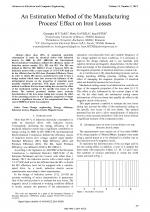| 2/2014 - 8 |
An Estimation Method of the Manufacturing Process' Effect on Iron LossesSCUTARU, G. |
| View the paper record and citations in |
| Click to see author's profile in |
| Download PDF |
Author keywords
design engineering, energy efficiency, induction motors, magnetic circuits, magnetic losses
References keywords
magnetic(20), materials(11), magnetism(10), influence(8), cutting(8), steels(7), steel(6), oriented(5), magnetics(5), stress(4)
No common words between the references section and the paper title.
About this article
Date of Publication: 2014-05-31
Volume 14, Issue 2, Year 2014, On page(s): 49 - 52
ISSN: 1582-7445, e-ISSN: 1844-7600
Digital Object Identifier: 10.4316/AECE.2014.02008
Web of Science Accession Number: 000340868100008
SCOPUS ID: 84901856074
Abstract
More than 60% of industrial electricity consumption is made by electrical drives with induction motors. In 2008, by IEC 60034-30, the International Electrotechnical Commission defined the efficiency classes of induction motors namely: IE1, IE2 and IE3. The IE4 was defined in 2010 by IEC 60034-3. From 1 January 2015, the induction motors with a rated output of 7.5-375 kW shall not be less efficient than the IE3 class (Premium Efficiency Class). In order to obtain IE3 motors, manufacturers need to have a design method which takes into account the influence of the technological process on the properties of materials used; specially magnetic properties. This paper presents a new method to estimate the iron losses taking into account the effect of the mechanical cutting on the specific iron losses of the sheets. The method presented enables more accurate determination of the iron losses taking into account the effect of the punching process on the magnetic properties of sheets without a significant increase of the computational time. The case of M400 iron sheets was analyzed. |
| References | | | Cited By |
Web of Science® Times Cited: 2 [View]
View record in Web of Science® [View]
View Related Records® [View]
Updated today
SCOPUS® Times Cited: 3
View record in SCOPUS® [Free preview]
View citations in SCOPUS® [Free preview]
[1] Experimental and statistical analysis of the effects of punching and laser cutting methods on induction motor efficiency and total magnetic losses in silicon lamination sheets, Bayraktar, Şenol, Turgut, Yakup, Journal of Magnetism and Magnetic Materials, ISSN 0304-8853, Issue , 2023.
Digital Object Identifier: 10.1016/j.jmmm.2023.170599 [CrossRef]
[2] Two Speed Single Phase Induction Motor with Electronically Controlled Capacitance, CAMPEANU, R., CERNAT, M., Advances in Electrical and Computer Engineering, ISSN 1582-7445, Issue 3, Volume 14, 2014.
Digital Object Identifier: 10.4316/AECE.2014.03018 [CrossRef] [Full text]
[3] Magnetic Flux Linkage and Iron Loss in Stator Design of Spindle Motor, Purwanto, Wawan, Arif, Ahmad, Setiawan, Muhammad Yasep, Andrizal, , Nursyafti, Yolana, Hidayat, Nuzul, 2023 International Conference on Modeling & E-Information Research, Artificial Learning and Digital Applications (ICMERALDA), ISBN 979-8-3503-6935-9, 2023.
Digital Object Identifier: 10.1109/ICMERALDA60125.2023.10458197 [CrossRef]
Disclaimer: All information displayed above was retrieved by using remote connections to respective databases. For the best user experience, we update all data by using background processes, and use caches in order to reduce the load on the servers we retrieve the information from. As we have no control on the availability of the database servers and sometimes the Internet connectivity may be affected, we do not guarantee the information is correct or complete. For the most accurate data, please always consult the database sites directly. Some external links require authentication or an institutional subscription.
Web of Science® is a registered trademark of Clarivate Analytics, Scopus® is a registered trademark of Elsevier B.V., other product names, company names, brand names, trademarks and logos are the property of their respective owners.
Faculty of Electrical Engineering and Computer Science
Stefan cel Mare University of Suceava, Romania
All rights reserved: Advances in Electrical and Computer Engineering is a registered trademark of the Stefan cel Mare University of Suceava. No part of this publication may be reproduced, stored in a retrieval system, photocopied, recorded or archived, without the written permission from the Editor. When authors submit their papers for publication, they agree that the copyright for their article be transferred to the Faculty of Electrical Engineering and Computer Science, Stefan cel Mare University of Suceava, Romania, if and only if the articles are accepted for publication. The copyright covers the exclusive rights to reproduce and distribute the article, including reprints and translations.
Permission for other use: The copyright owner's consent does not extend to copying for general distribution, for promotion, for creating new works, or for resale. Specific written permission must be obtained from the Editor for such copying. Direct linking to files hosted on this website is strictly prohibited.
Disclaimer: Whilst every effort is made by the publishers and editorial board to see that no inaccurate or misleading data, opinions or statements appear in this journal, they wish to make it clear that all information and opinions formulated in the articles, as well as linguistic accuracy, are the sole responsibility of the author.





